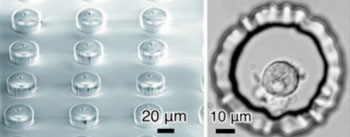Hollow Microprobe Array Enables Isolation and Manipulation of Single Cells
By LabMedica International staff writers
Posted on 05 May 2015
A team of Japanese biomechanical engineers has developed a novel technique for isolating and manipulating single cells.Posted on 05 May 2015
Investigators at Toyohashi University of Technology (Japan) used microelectromechanical systems fabrication technology to construct an array of hollow probes for the manipulation of single cells. They conducted a cell aspiration experiment with a glass pipette and modeled a cell using a standard linear solid model, which provided information for designing hollow stepped probes for minimally invasive single-cell manipulation.

Image: The photograph shows a silicon wafer microprobe array and a single cell isolated in a microwell (Photo courtesy of Toyohashi University of Technology).
The investigators etched a silicon wafer on both sides and formed holes with stepped structures that passed through the wafer. In order to trap cells, the inner diameters of the holes were reduced by plasma-enhanced chemical vapor deposition of SiO2. This fabrication process facilitated control of wall thickness, inner diameter, and outer diameter of the probes.
In experiments conducted with the fabricated probes, single cells were manipulated and placed in microwells at a single-cell level in a parallel manner. The investigators studied the capture, release, and survival rates of cells at different suction and release pressures. They reported in the March 2015 online edition of the journal Biomedical Microdevices that the cell trapping rate was directly proportional to the suction pressure, whereas the release rate and viability decreased with increasing the suction pressure. The proposed manipulation system allowed placement of cells in a well array for observance of adherence, spreading, culture, and death of the cells.
"We fabricated an array of hollow microprobes with designed diameters, heights, and numbers from a silicon substrate using microfabrication techniques," said first author Dr. Moeto Nagai, assistant professor of biomechanical engineering at Toyohashi University of Technology. "Single cells were trapped on the tips of the probes using a suction flow. The cells were then released and placed in an array of microwells. Parallel and versatile cell manipulation tools are essential for biomedical innovation, and microfabrication technologies offer massively parallel microstructures close to a human cell in size."
Related Links:
Toyohashi University of Technology














